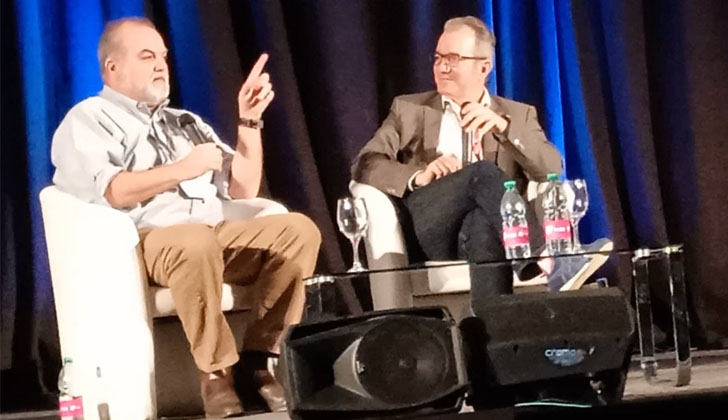
The debate was moderated by Marcos Pueyrredon, Co-Founder & Global Executive SVP, VTEX, and President, eCommerce Institute.
In this framework, Christopher Jones, CEO of Ta-Ta SA, a professional with more than 20 years of experience as a recognized disruptive leader in Omni Channel, Digital, Supply Chain, Logistics, Retail Store Operations, Business Processes and Information Systems, He expressed that the current challenge is how to accept all the client’s demand in a positive way and all the decision experiences.
“Every day we try to solve the challenge of how to make it so that a client in Treinta y Tres, Melo or Tacuarembo can decide how they want to make their purchases, that is, if they prefer physically in a Ta-Ta store, or from the comfort of your home, and that the product arrives directly at the house”.
He said that in the end the “Stock Keeping Unit” (better known by its acronym SKU, an alphanumeric identifier that allows individualizing the products in a catalog) is not the only thing, nor is the price, but the different values and factors that motivate to each of the customers to make their purchases.
Jones commented that the industry used to “force” the “Customer Journey” (or the journey that a customer takes during the purchase process), while today the customer has all the options and all the necessary doors to be able to evacuate their doubts and do what you want the way you want to do it.
Regarding “unified commerce”, he said that “everything is simpler when everything is in front of the consumer”, and exemplified that last Christmas tens of thousands of customers entered the different Ta-Ta stores, in the 19 departments of the country, “to look for their purchases that they had made online in Tiendamía, and, in turn, they acquired other merchandise for the holidays; That was the clear example that everything changed.”
“That is to say, they made a purchase in Miami, the merchandise arrived in Carrasco, we picked it up, we took it to each of our stores, the customers had the possibility of seeing where the merchandise was, and in turn that merchandise was being monitored with merchandise our eCommerce. That client was going to buy merchandise at our stores or receiving merchandise at his house, ”he detailed.
Regarding the role of operation and logistics, the CEO of Ta-Ta said that “it is very important that the architectures that are created for these Journeys have to be extremely transparent with customers.”
“Something that arrives to the buyer on the same afternoon of the day it was purchased does not cost the same as something that will arrive within a week,” he said. In other words, the client would decide how much he is willing to pay for the service and for that good, at the time that suits him best.
“We are investing in continuous improvement of our software capabilities. In this sense, we speak of the physical world, the logical world, and the accounting world. The physical is what has to be moved at the speed that has been decided, the logical aspect is that it cannot be lost sight of and there must always be visibility of the state of the merchandise, and the accounting thing is to monetize”, explained Jones.
He exemplified: “The producer of a jelly in Florida delivers his product to Ta-Ta’s ‘Customer Service’ so that it is received by a customer on the other side of the country, and that works. The client does exactly the same, there has to be ‘full visibility’ and physically things have to move without any inconvenience”.
In this framework, he pointed out that Ta-Ta has a competitive advantage since it transports back and forth to all departments 365 days a year and can always be moving cargo. “Today we have the best price cargo service in Uruguay for our customers. The battle is in how we do so that as the demands of our clients become more sophisticated, that architecture has a solid base to be able to adapt”.

More transactions bring more data
Jones referred to the different algorithms to personalize purchases. He said that currently, Ta-Ta has 1.8 million “loyal” clients in Uruguay and, in turn, 100 thousand transactions per day.
“We go straight to customization. Our team has already figured out the odds per customer for each SKU we have. We have a powerful ‘demand elasticity’ and ‘price and demand elasticity’ engine, which instead of making it run per store, we make it run for each client and with high probabilistic chances we know how much a client would be willing to pay for a bottle of wine of a certain brand”, he explained.
In this sense, he said that “predictive marketing” can be taken to something nominal with a first and last name and in turn executed.
Work is also being carried out to find out which routes the customer prefers when making a purchase, that is, what wine they want, at what price on the gondola, or if it is delivered to their home. This can be “predictive” even before it is known that you are going to acquire it.
It is an algorithm that feeds on the information provided by the client and can predict what it wants and when it will want it.
The same transaction can occur in different ways: telephone, WhatsApp, web page, or in person. Therefore, the challenge is to be able to help the client to decide.
He also referred to the importance of analyzing the recurrence of purchase based on the “RFM” model (Recency, Frequency, Monetary value, in Spanish: Actuality, Frequency, Monetary value).
“That is, knowing the last time the customer visited the store, how many times he did it and the monetary value of his purchases. By having one model per client, we will know what we have to offer to improve each client’s RFM, and we continually measure this,” he said.
On the other hand, he mentioned the investment experiences and “web 3”, in this sense, he pointed out that “the first steps are being taken”.
From the point of view of “pure ritail” (sale of final products to the consumer), he assured that the supplier industry will benefit. He added that for all the content that can be seen today in “flat” format, a “3D” format will have to be created.

















